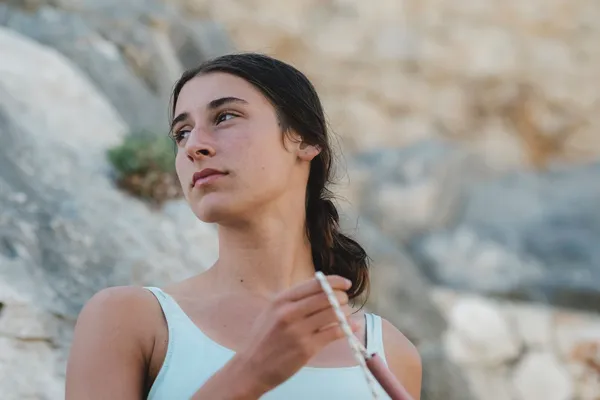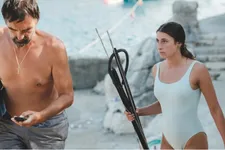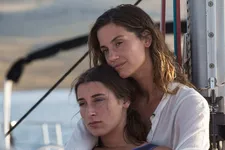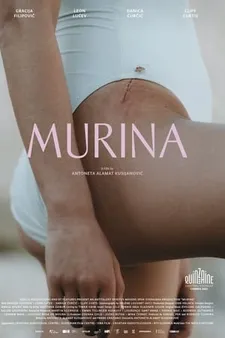 |
| Gracija Filipovic as Julija in Murina Photo: courtesy of Glasgow Film Festival |
Winner of the prestigious Camera d’Or at the 20201 Cannes Film Festival, Antoneta Alamat Kusijanovic’s début feature film, Murina, was named Best Film at the Sarajevo and São Paulo film festivals and was a hit with the audience at this year’s Glasgow Film Festival. It follows a teenage girl, Julija, whose longing for a better life becomes acute during a visit from her father’s wealthy foreign friend, with whom he is trying to make a business deal. Frustrated by her father’s controlling ways, she tries to persuade his friend to take his place in her family, but adult motives are not as simple as they appear. It features the same characters – and the same young star, Gracija Filipovic – as Antoneta’s 2017 short Into The Blue, so when we met to discuss it, I started by asking her about the relationship between the two.
“When I started making Into The Blue, I was really going from images of growing up on an island that I would go to during the summers with my grandmother and we were always like free, unattended kids running around, you know, hormones and nature and very wild. I did not have an idea of making Murina as a sequel to it. It was a standalone piece. But what happened is working with Gracija on Into The Blue, I wanted to write a feature for her specifically, to capture her at that age and the transition into adulthood.”
The film opens with striking scenes of father and daughter underwater, hunter for eels (the ‘murina’, or morays, of the title).
“Shooting underwater, you know, it’s like going into space: you can't go unprepared,” she says. “You can’t breathe, you can’t communicate, your movement is limited. It’s very important to have an extra level of preparation and clarity for the scenes, and not only preparation in terms of the artistic, and creatively, but also logistically and also preparing actors for the specific circumstances in which you're going to shoot. Actors and the crew, separately and together.”
There’s another underwater scene, later in the film, which takes place at night and seems still more dangerous due to the cave environment in which it’s set.
 |
| Murina Photo: Courtesy of Director's Fortnight |
“My grandmother actually recommended me to shoot in that location because it’s the location where she used to swim as a girl. It was very surreal to even imagine shooting there because it's completely on the outskirts of the island where there's no road. The only way you can approach it is by a boat. It's by the lighthouse. It was literally a hole in between the rocks out in the middle of nowhere, but it happened to be the easiest location because it really gave us everything we needed with the minimum of safety threats. So, yeah, we shot most of the sequence there except certain things we did in the studio. And I loved it because we shot during the night and we had to light underwater and especially this cave that was 40 metres deep. And we had our underwater divers not at the bottom of the cave but below, where camera cannot see them, watching out for our crew and for the actress. Everybody was truly emotionally and physically submerged.”
Gracija originally came to be cast in Into The Blue because she was a professional swimmer, she explains, and I ask her how she found the right balance in shooting her young star, because the camera makes it clear that other people see the girl as sensually and sexually appealing, but that’s not how she sees herself.
“I actually wanted to portray her as an animal,” Antoneta explains. “She's like this slithering eel, at ease with her body, at ease with water, one with nature, and actually absolutely unaware of how she's seen, because she's not ever really seen. You know, being in this isolation in this house on this island. She's in a cave, you know, like morays, you don't see them swimming free out in the water. And they have this gorgeous movement but that's not for our eyes. They're all hiding in this cave. She's not aware of her sensuality and the way others can see her. But the reason why she can move that way she moves, it’s not about her and not offensive because it really portrays honest, raw movement without an agenda for a young adult. That's how they are.”
There's a scene where her mother puts her in a dress for a dance to try and make her look more appropriate, as she sees it, and it makes her seem a lot less in control of herself. Is she being tamed there?
“Yes, but also it's like, you know, if you if you take an animal and you dress the animal in a suit. For her, wearing a bathing suit is not for sensuality. It’s just because that is the comfortable costume that she needs to perform her role in the house and in the sea. Swimming. Being in this environment. It's her uniform.”
The story is framed very much from Julija’s point of view, so how did Antoneta approach bringing in the other characters to reveal how complex they are?
“I would say that this is a four protagonist story told from the point of view of one,” she agrees. “We are definitely closer to Julija. It comes from almost two different points of view. One is watching the adults and their dynamics through Julija’s eyes, and watching Julija through other people's eyes – but both lead us into this one singular emotion, which is how Julija is being perceived, and how Julija sees.”
 |
| Julija and her mother Photo: Anitalent, RT Features |
We discuss the teenager’s response to her father’s controlling behaviour.
“I think that actually Julija is aware of that control,” says Antoneta. “She just has never had the playground in which she would push that control to its limit. There was no reason, there was no catalyst for that control that was constant to go to full blown fire. So what seems to be her becoming aware, it's more of her inciting it to see how far it can go. Like babies do – they really push and push to see at which point you're going to blow. And that's what Julija does, because she wants to expose it. That is the only thing she can do.”
When it came to casting, finding the right chemistry within the group was essential, she explains.
“I really cast everybody around her. So once I had my top picks, I would bring everyone to the room with Gracija. And then once a character would be cast, I would bring two characters to cast a third character. So I worked like that for a couple of months until I got my team and then they spent probably one month together living in a house to find the dynamics of the family of the people who don't need to speak to understand each other. That was important for me: that it feels that this life and this family reaches beyond the screen.
“We never did extensive rehearsals of the scenes. We played a lot on other types of scenes that could have happened in this movie, but we are just not depicting them. So there was a lot of like, family constellation and embodying these characters through daily actions, you know, fishing or cooking together or being together on the sea or going to church. We did all of these things for three, four weeks
“Some of the most important scenes we rehearsed, that needed logistical preparation like underwater handling with the harpoon. You know, physical moments about all of these things that are second nature, around the boat, around all these fishing tools, with the equipment, or the things that needed to become part of them, we kind of lived them.”
The house as well has a very lived-in feeling, I note. She tells me that when she found it, she immediately knew that it was where she wanted to shoot.
“We had to hike to location 20 minutes every day, back and forth. So to bring electricity there and catering and equipment and everything that you need for a set of 100 people, you can imagine how remote and difficult that was, but it was the right location. It was the only house on the Adriatic that was in the bay, from the 16th century 14th century, that was unfazed by this modern hand. And not only the house itself, but the entire bay. And there were no green trees around, which was very important for me because I wanted nature that has no shade. I wanted this colour palette that is mostly yellow, and blue and grey. That was very important for the characters to have no cool moments to think, to revise their impulses, to hide – they had to always be exposed like that.”
 |
| Murina poster |
There's an awful lot of very beautiful scenery in the film. I wondered if it would be limiting to be shooting somewhere like that, where there’s bright light all the time.
“We had to plan a lot around nature and the light because that was our only tool. We could not work with lamps. So yes, it was. We had to get creative. Hélène [Louvart] is a master, my cinematographer, and she did such a great thing with the camera and lights. And also together with our team planning the shoot, so we could use the natural light as our gift instead of an antagonistic force on the set.”
So how does she feel about the attention the film got in Cannes?
“I was never making a film for the festival,” she says. “I'm making the film for the audience. Of course, it always comes from something that you want to tell, but I don't need to make it for myself. So I was expecting, I was hoping that the film would have a strong reaction from the audience. And I like polarised ones, I like the reactions both good and passionate, and those who are also passionately negative. I think these are the best reviews. So I think it's going to work on the audience in the way we built it and expected and hoped it would work. Now with the festivals, you never know. It depends on so many things, especially like that moment in time and what is really happening in the world. And I was surprised. I left Cannes” She laughs. “I didn't think I would receive a Camera d’Or!”
If you enjoy Murina, you’ll be pleased to learn than Antoneta plans to explore adjacent ideas in her next project.
“I'm now working on my second feature. It's something that I wrote a long time ago, really like my first feature but the scope of it was not right for a first film. It is kind of leaning again on motherhood but it's more like what's happening in the shadow of Murina now comes forward. These characters are in a different world. If the antagonism of Murina is isolation mentality and men, on motherhood and the coming of age young woman, now the antagonists of the mother and daughter are themselves. There's no man around them. It’s the different society antagonism that I'm depicting.”
Murina will be in cinemas across the UK from Friday 8 April.





















